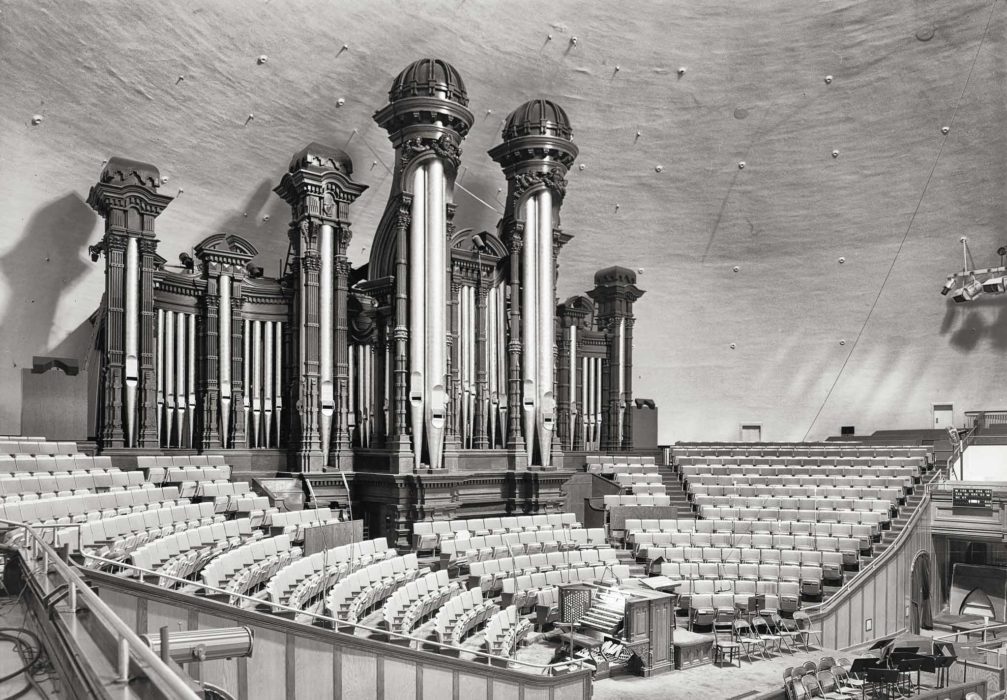A FLICKERING SWARM OF bees circled the hive many stories above ‘Abdu’l-Bahá’s head. They were fashioned from light bulbs whose filaments blinked as if to suggest busyness. The illuminated hive formed the heart of the blazing Star of Utah — symbols of a state that had boldly reduced its motto to a single word: “Industry.” It was the centerpiece of a massive pipe organ, draped in American flags, which bellowed forth the Grand March from Verdi’s opera, Aida.
‘Abdu’l-Bahá gazed out at 12,000 spectators as Lucile Francke, dressed as the Queen of Irrigation and Empress of the Valley, climbed the stage of the Mormon Tabernacle and mounted her throne on the uppermost tier of the platform. At 10 a.m. on September 30, 1912, she gave the order for the proceedings of the twentieth annual convention of the National Irrigation Congress to begin.
‘Abdu’l-Bahá had arrived in the city the day before. The streets were decked with patriotic regalia, and overflowed with visitors. The annual state fair was also occurring that week, side by side with the convention of the Irrigation Congress. ‘Abdu’l-Bahá had planned a short stopover in Salt Lake City on his way to California, but decided to extend his stay. Shortly after his arrival he received an invitation to sit on the stage as an honorary guest the following morning.

The Mormon Tabernacle, a long, domed space shaped like a longhouse, lay next to the Mormon Temple in Temple Square. Its ceiling was painted white like a planetarium, as if to evoke the desert sky; the seats beneath it had begun to fill at 9 a.m. The convention was no small event, with 1,000 official delegates from throughout the United States, and more than 11,000 visitors. The President of the Irrigation Congress, Francis G. Newlands, a United States Senator from Nevada, noted that the event’s focus was the creation of a national policy for the regulation of waterways. The American states west of the Mississippi had started a series of massive irrigation projects a decade earlier, designed to bring rural prosperity to otherwise barren land. In their scope and complexity they rivaled the Panama Canal. By 1912 they were nearing completion.
“It is with joy and pleasure that we gaze upon the fruitful fields scattered over these bountiful valleys,” the Queen announced. ‘Abdu’l-Bahá listened as she dedicated the week to the “workers in this great field of endeavor, who are driving back the desolation of the desert; to you who with your brains and hands have transformed these waste spaces into smiling gardens.”
Governor Spry of Utah took the podium and noted that Salt Lake City had been the first to introduce modern irrigation in America. “You have come to the place where irrigation has been, and is yet the mightiest factor in our civilization,” he said. ‘Abdu’l-Bahá looked on as the city’s mayor, Samuel C. Park, spoke of the mutual interests of all those present. “The irrigation system of a community may be likened to the circulatory system of the individual,” he noted. “It is the blood of our commercial and industrial development.” “Take it away and we have got to move,” he added, “Waste it and our children will have to go.”
As the opening ceremonies came to a close, ‘Abdu’l-Bahá wandered out into the pavilions at the State Fair. There were segments devoted to produce and livestock, mining and manufacturing, and a circus-like midway that featured horse racing, parachuting, and a high-wire act.
Later that evening, he attended the “Electrical Pageant,” a parade through the downtown core, its floats festooned with thousands of electrical bulbs. The windows of every building “were black dots of humanity” the Salt Lake Tribune reported. It was a grand display of American industriousness, of rural and urban cooperation, and of the growing economic interdependence of a nation.
So began the “BIGGEST WEEK IN THE HISTORY OF SALT LAKE CITY,” the Tribune declared the next morning.






